-
Reagents
- Flow Cytometry Reagents
-
Western Blotting and Molecular Reagents
-
Flow Cytometry Reagents
- Immunoassay Reagents
- Single Cell Multiomics Reagents
-
Cell Preparation
-
Functional Assays
-
Microscopy and Imaging Reagents
- Western Blotting And Molecular Reagents
- Cell Preparation Separation Reagents
- Functional Cell Based Reagents
- Microscopy Imaging Reagents
- Single Cell Multiomics Reagents
- Single Cell Multinomics Reagents
-
Protocols
- BSB Protocol
-
Setting Compensation Multicolor Flow
-
Tissues Section Stain
-
Immunomicroscopy
-
Immunohistochemical
-
Immunofluorescence
-
Frozen Tissue
-
Parafin Sections
-
Fix Perm Kits
-
Protocol Direct Immunofluorscence Staining
-
Uses of Fc Block
-
Stain Lyse Wash
-
Stain Lyse No Wash
-
Mouse Splenocytes
-
Mouse Rat Leukocytes
-
Isotype Control
-
Indirect Staining Mononuclear Cells
-
Immunopurification
-
Human PBMCs
-
Human Whole Blood Samples
-
Escapee Phenomenon
-
Agarose Conjugates
-
Anti Phosphotyrosine Biotin Conjugates
-
Soluble Antibodies
-
Rabbit Polyclonal Antibodies
-
Monocloncal Antibodies
-
Horseradish Peroxidase
-
Certified Reagents
-
Biotinylated Antibodies
-
Agarose Conjugates X712261
-
Surface Staining
-
Platelet Activation
-
Intracellular Staining
-
Indirect Immunofluorescence
-
Mouse Ige
-
Cytokine Elisa
-
Induction Fas
-
Induction Dx2
-
Apoptosis By Treatment Staurosporine
-
Cell Death
-
Apo Brdu
-
Apo Direct
-
Human Cyclins
-
Detection Ki 67
-
Brdu Detection
-
Targeted mRNA Protocols
-
WTA Protocols
-
360040667732 Protocols
-
360023293831 AbSeq Protocols
-
360039007471 VDJ CDR3 Protocols
-
Annexin V Staining Protocol
-
Western Blotting with Horseradish Peroxidase Conjugates or Alkaline Phosphatase Conjugates
-
Tissue Preparation for Surface Antigen Staining
-
Account Support
-
Account FAQs
- Account FAQ Answer 1
- Account FAQ Answer 2
- Account FAQ Answer 3
- Account FAQ Answer 4
- Account FAQ Answer 5
- Account FAQ Answer 6
- Account FAQ Answer 7
- Account FAQ Answer 8
- Account FAQ Answer 9
- Account FAQ Answer 10
- Account FAQ Answer 11
- Account FAQ Answer 12
- Account FAQ Answer 13
- Account FAQ Answer 14
- Account FAQ Answer 15
- Account FAQ Answer 16
- Account FAQ Answer 21
- Create Account
- Manage Account Settings
-
PrivacyPolicy
-
Terms and Conditions
-
Account FAQs
-
- Account FAQ Answer 1
- Account FAQ Answer 2
- Account FAQ Answer 3
- Account FAQ Answer 4
- Account FAQ Answer 5
- Account FAQ Answer 6
- Account FAQ Answer 7
- Account FAQ Answer 8
- Account FAQ Answer 9
- Account FAQ Answer 10
- Account FAQ Answer 11
- Account FAQ Answer 12
- Account FAQ Answer 13
- Account FAQ Answer 14
- Account FAQ Answer 15
- Account FAQ Answer 16
- Account FAQ Answer 21
- Korea (English)
- Korea (Korea)
-
국가 / 언어 변경
Old Browser
Absorption and Emission Spectra
When making decisions about which fluorochromes to use in your experiments, you'll want to know their relative emission spectra. Simply click on the representative spectrum colors to view histograms that represent the absorption and emission spectra for each BD fluorochrome.
-
BD Horizon Brilliant™ Ultraviolet 395 (BUV395) (Ex-Max 348 nm/Em-Max 395 nm)
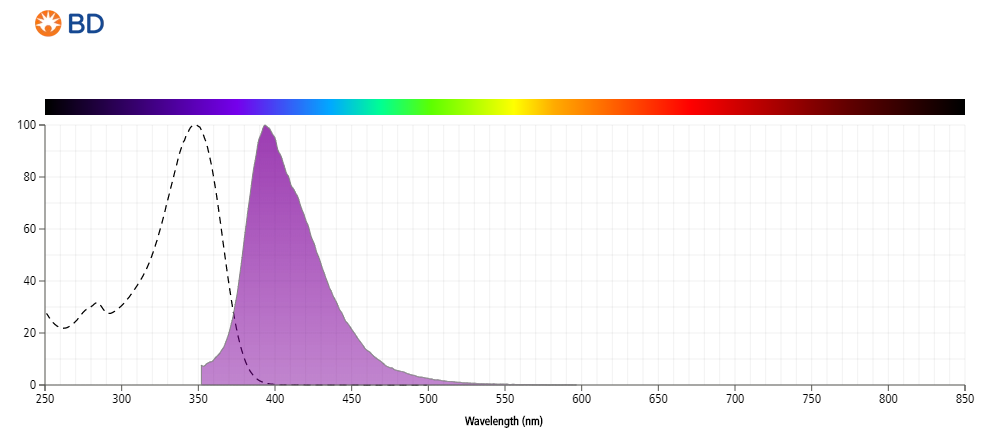
The BD Horizon Brilliant™ Ultraviolet 395 (BUV395) Dye is part of the BD Horizon Brilliant™ Ultraviolet family of dyes. This base dye is a polymer fluorochrome with an excitation maximum (Ex-Max) of 348 nm and an emission maximum (Em-Max) at 395 nm. Driven by BD innovation, BUV395 is designed to be excited by the ultraviolet laser (355 nm) and detected using an optical filter centered near 380 nm (e.g., 379/28-nm bandpass filter). BUV395 is the ideal dye when using only one detector on the ultraviolet laser as it spills into no other detectors and no other fluorochromes spill into it.
-
BD Horizon Brilliant™ Ultraviolet 496 (BUV496) (Ex-Max 350 nm/Em-Max 496 nm)
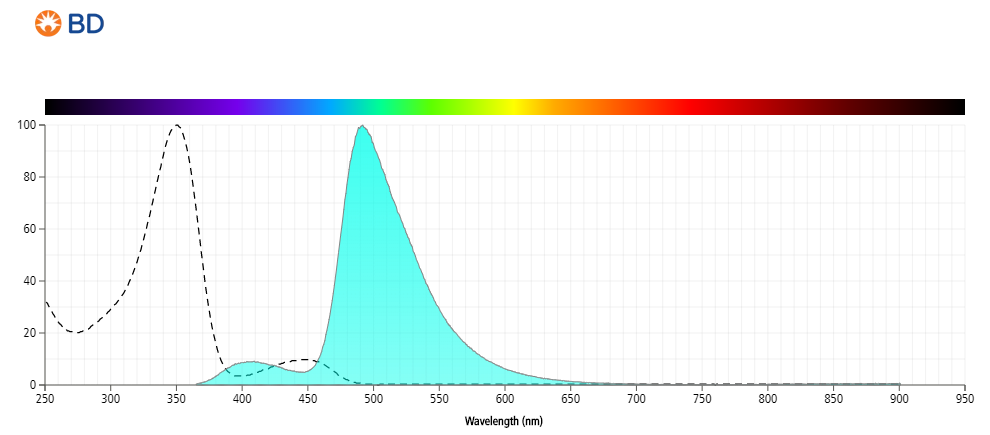
The BD Horizon Brilliant™ Ultraviolet 496 (BUV496) Dye is part of the BD Horizon Brilliant™ Ultraviolet family of dyes. This tandem fluorochrome is comprised of a BUV395 donor with an excitation maximum (Ex-Max) of 350 nm and an acceptor dye with an emission maximum (Em-Max) at 496 nm. BUV496, driven by BD innovation, is designed to be excited by the ultraviolet laser (355 nm) and detected using an optical filter centered near 500 nm (e.g., 515/30-nm bandpass filter). The acceptor dye can be excited by the violet (405 nm) laser resulting in cross-laser excitation and fluorescence spillover.
-
BD Horizon Brilliant™ Ultraviolet 563 (BUV563) (Ex-Max 350 nm/Em-Max 564 nm)
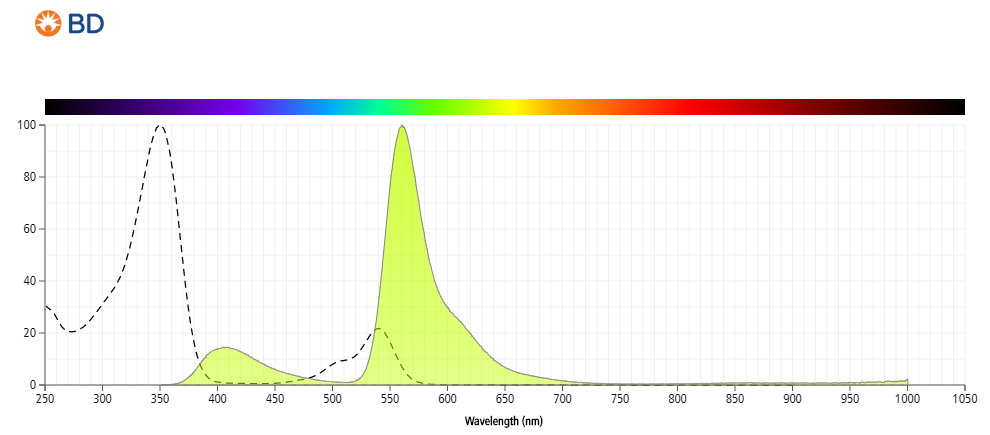
The BD Horizon Brilliant™ Ultraviolet 563 (BUV563) Dye is part of the BD Horizon Brilliant™ Ultraviolet family of dyes. This tandem fluorochrome is comprised of a BUV395 donor with an excitation maximum (Ex-Max) of 350 nm and an acceptor dye with an emission maximum (Em-Max) at 564 nm. BUV563, driven by BD innovation, is designed to be excited by the ultraviolet laser (355 nm) and detected using an optical filter centered near 560 nm (e.g., 560/40- or 585/15-nm bandpass filter). The acceptor dye can be excited by the blue (488 nm) laser resulting in cross-laser excitation and fluorescence spillover.
-
BD Horizon Brilliant™ Ultraviolet 615 (BUV615) (Ex-Max 350 nm/Em-Max 615 nm)
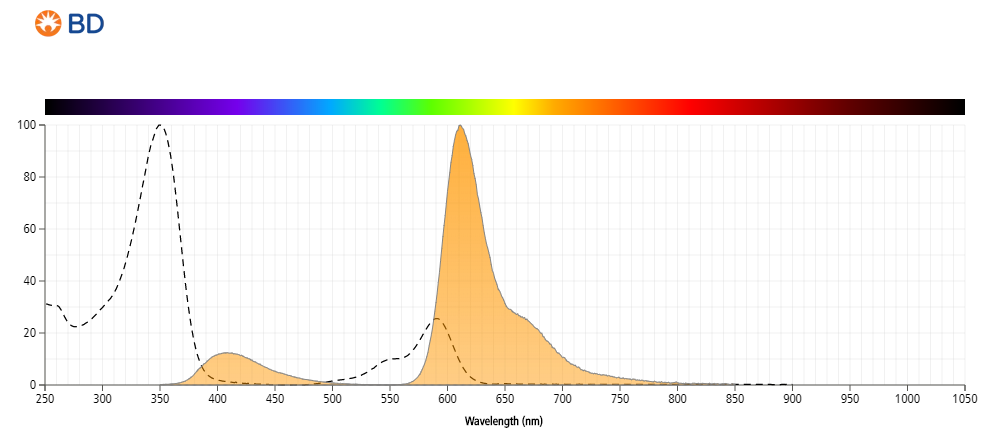
The BD Horizon Brilliant™ Ultraviolet 615 (BUV615) Dye is part of the BD Horizon Brilliant™ Ultraviolet family of dyes. This tandem fluorochrome is comprised of a BUV395 donor with an excitation maximum (Ex-Max) of 350 nm and an acceptor dye with an emission maximum (Em-Max) at 615 nm. BUV615, driven by BD innovation, is designed to be excited by the ultraviolet laser (355 nm) and detected using an optical filter centered near 615 nm (e.g, 610/20-nm bandpass filter). The acceptor dye can be excited by the blue (488 nm) and yellow-green (561 nm) lasers resulting in cross-laser excitation and fluorescence spillover.
-
BD Horizon Brilliant™ Ultraviolet 661 (BUV661) (Ex-Max 350 nm/Em-Max 660 nm)
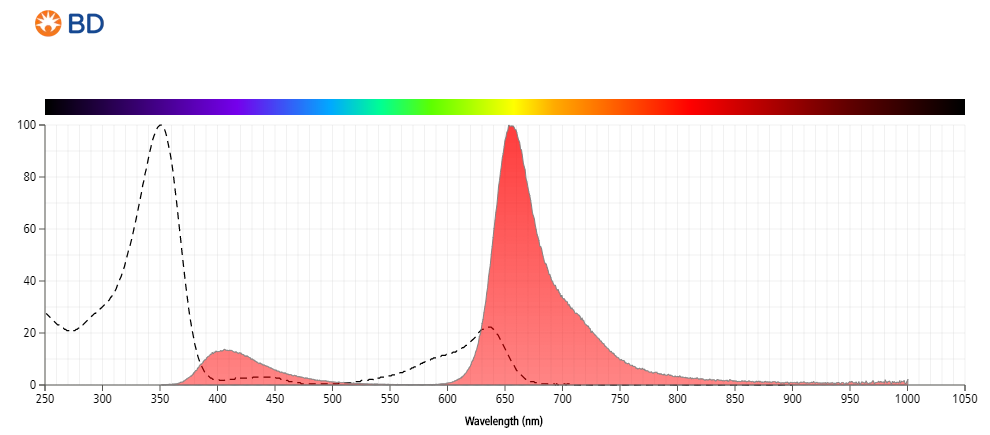
The BD Horizon Brilliant™ Ultraviolet 661 (BUV661) Dye is part of the BD Horizon Brilliant™ Ultraviolet family of dyes. This tandem fluorochrome is comprised of a BUV395 donor with an excitation maximum (Ex-Max) of 350 nm and an acceptor dye with an emission maximum (Em-Max) at 660 nm. BUV661, driven by BD innovation, is designed to be excited by the ultraviolet laser (355 nm) and detected using an optical filter centered near 660 nm (e.g., 670/25-nm bandpass filter). The acceptor dye can be excited by the red (628–640 nm) laser resulting in cross-laser excitation and fluorescence spillover.
-
BD Horizon Brilliant™ Ultraviolet 737 (BUV737) (Ex-Max 350 nm/Em-Max 735 nm)
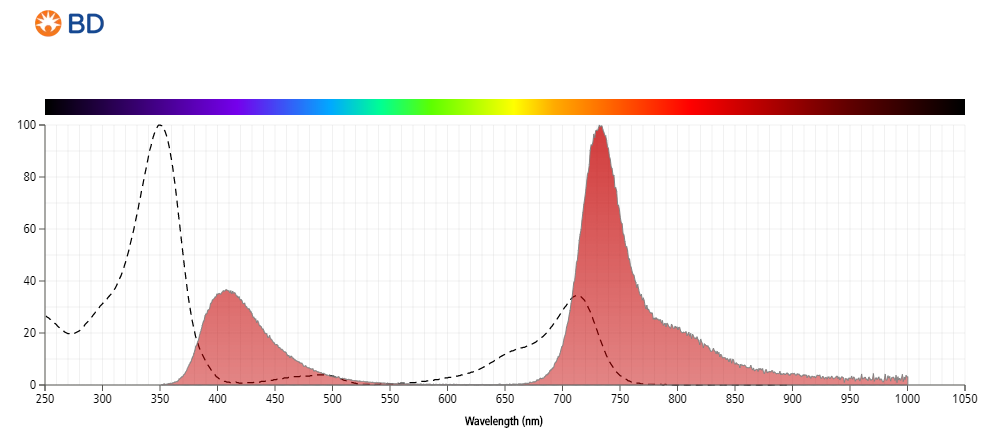
The BD Horizon Brilliant™ Ultraviolet 737 (BUV737) Dye is part of the BD Horizon Brilliant™ Ultraviolet family of dyes. This tandem fluorochrome is comprised of a BUV395 donor with an excitation maximum (Ex-Max) of 350 nm and an acceptor dye with an emission maximum (Em-Max) at 735 nm. BUV737, driven by BD innovation, is designed to be excited by the ultraviolet laser (355 nm) and detected using an optical filter centered near 740 nm (e.g., 740/35-nm bandpass filter). The acceptor dye can be excited by the red (628–640 nm) laser resulting in cross-laser excitation and fluorescence spillover.
-
BD Horizon Brilliant™ Ultraviolet 805 (BUV805) (Ex-Max 351 nm/Em-Max 803 nm)
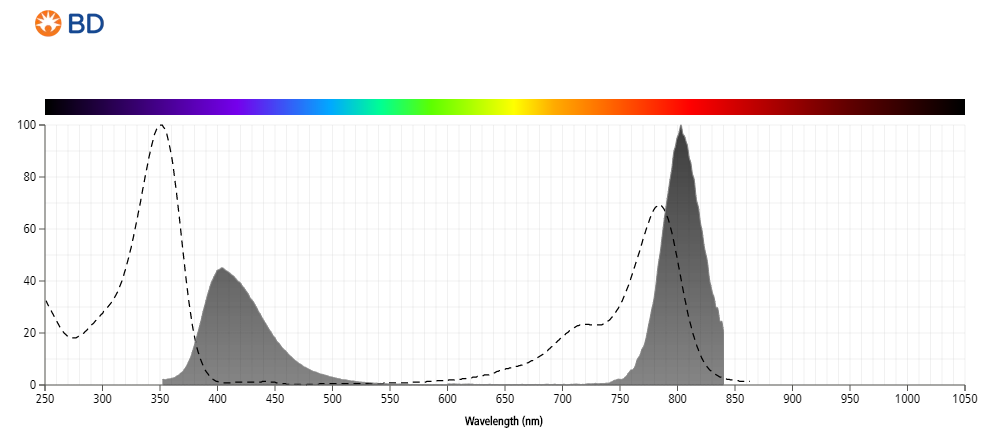
The BD Horizon Brilliant™ Ultraviolet 805 (BUV805) Dye is part of the BD Horizon Brilliant™ Ultraviolet family of dyes. This tandem fluorochrome is comprised of a BUV395 donor with an excitation maximum (Ex-Max) of 351 nm and an acceptor dye with an emission maximum (Em-Max) at 803 nm. BUV805, driven by BD innovation, is designed to be excited by the ultraviolet laser (355 nm) and detected using an optical filter centered near 805 nm (e.g., 820/60- or 780/60-nm bandpass filter).
-
Pacific Blue™ (Ex-Max 404 nm/Em-Max 455 nm)
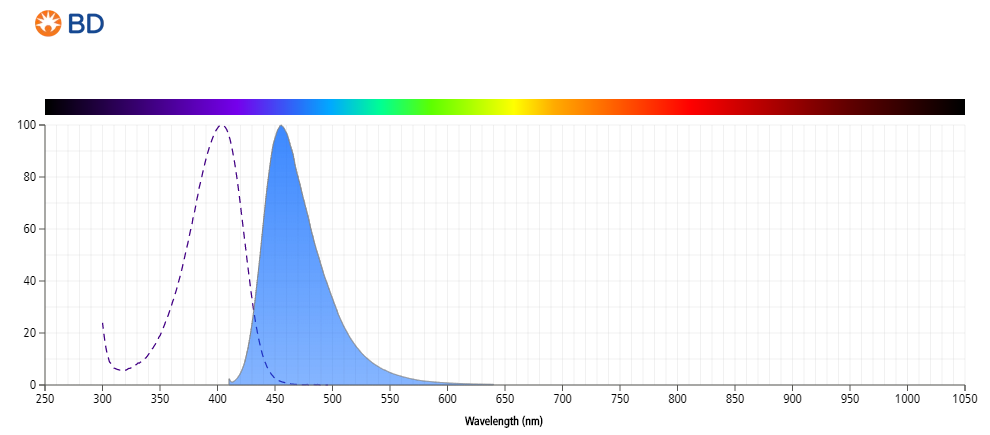
Pacific Blue™ is part of the BD violet family of dyes. This is a small organic fluorochrome with an excitation maximum (Ex-Max) at 404 nm and an emission maximum (Em-Max) at 455 nm. Pacific Blue™ is designed to be excited by the violet laser (405 nm) and detected using an optical filter centered near 450 nm (e.g., 450/50-nm bandpass filter).
-
BD Horizon Brilliant Violet™ 421 (BV421) (Ex-Max 407 nm/Em-Max 423 nm)
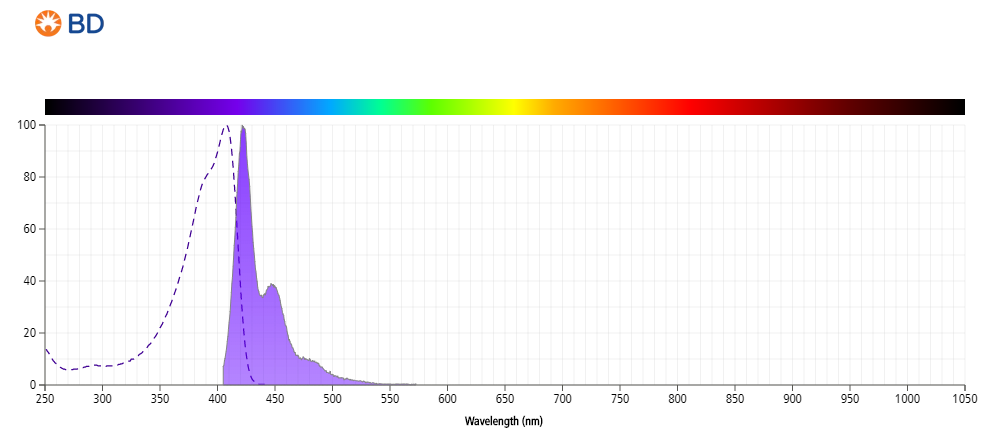
The BD Horizon Brilliant Violet™ 421 (BV421) Dye is part of the BD Horizon Brilliant Violet™ family of dyes. This polymer-technology based dye has an excitation maximum (Ex-Max) of 407 nm and an emission maximum (Em-Max) at 423 nm. Driven by BD innovation, BV421 is designed to be excited by the violet laser (405 nm) and detected using an optical filter centered near 420 nm (e.g., 431/28- or 450/50-nm bandpass filter). BV421 is an ideal alternative for V450 as it is approximately ten times brighter with less spillover into the BV510/V500 detector.
-
BD Horizon™ Violet 450 (V450) (Ex-Max 405 nm/Em-Max 450 nm)
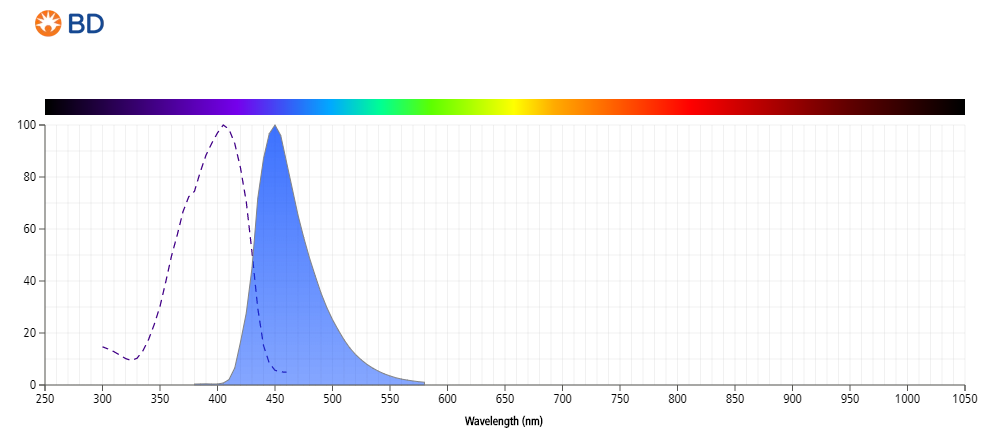
BD Horizon™ Violet 450 (V450) Dye is part of the BD Horizon™ Violet family of dyes. This is a small organic fluorochrome with an excitation maximum (Ex-Max) at 405 nm and an emission maximum (Em-Max) at 450 nm. V450, driven by BD innovation, is designed to be excited by the violet laser (405 nm) and detected using an optical filter centered near 450 nm (e.g., 450/50-nm bandpass filter). The dye can be excited by the UV (355 nm) laser resulting in cross-laser excitation and spillover.
-
BD Horizon Brilliant Violet™ 480 (BV480) (Ex-Max 440 nm/Em-Max 479 nm)
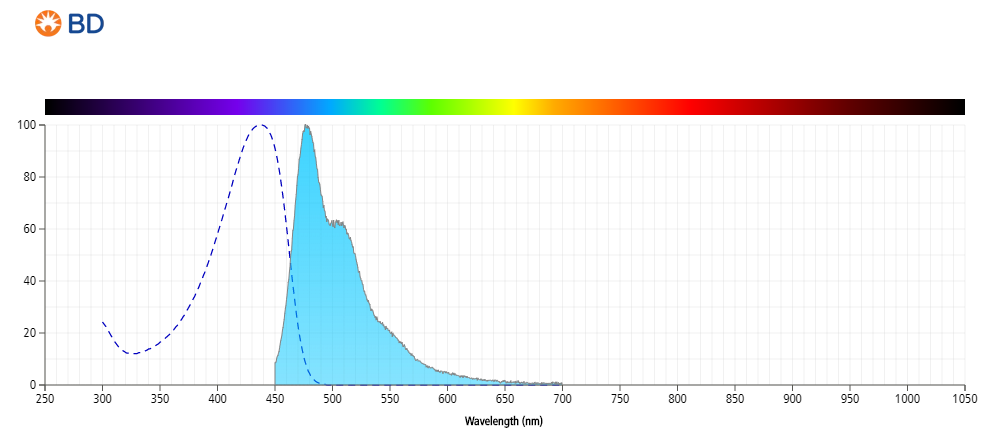
The BD Horizon Brilliant Violet™ 480 (BV480) Dye is part of the BD Horizon Brilliant Violet™ family of dyes. This polymer-technology fluorochrome has an excitation maximum (Ex-Max) of 440 nm and an emission maximum (Em-Max) of 479 nm. Driven by BD innovation, BV480 is designed to be excited by the violet laser (405 nm) and detected using an optical filter centered near 480 nm (e.g., 525/50-nm bandpass filter). The increased fluorescence intensity of BV480 and narrower emission spectra make it a good alternative to BV510 or V500. Due to its excitation profile, BV480 also has less cross-laser excitation with the UV laser, resulting in less spillover into UV channels compared to BV510.
-
BD Horizon™ Violet 500 (V500) (Ex-Max 415 nm/Em-Max 500 nm)
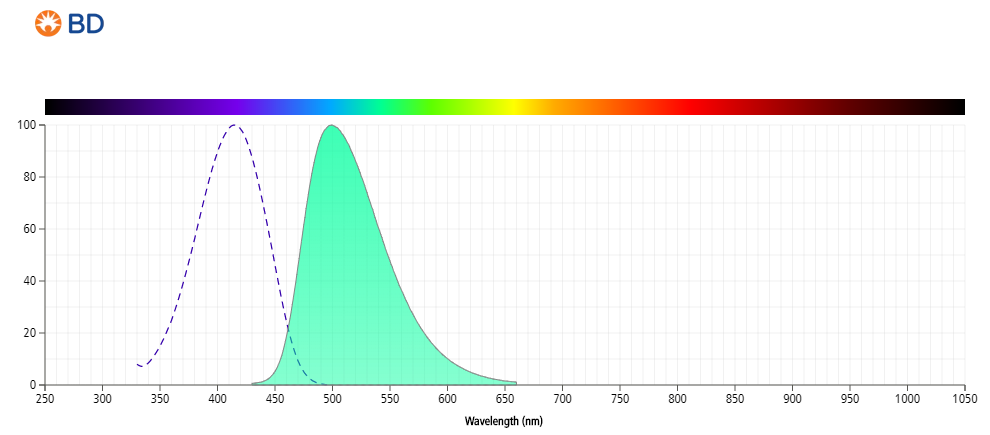
BD Horizon™ Violet 500 (V500) Dye is part of the BD Horizon™ Violet family of dyes. This is a small organic fluorochrome with an excitation maximum (Ex-Max) at 415 nm and an emission maximum (Em-Max) at 499 nm. Driven by BD innovation, V500 is designed to be excited by the violet laser (405 nm) and detected using an optical filter centered near 500 nm (e.g., 525/50-nm bandpass filter).
-
AmCyan (Ex-Max 457 nm/Em-Max 489)

The AmCyan dye is part of the BD violet family of dyes. This dye is a fluorescent protein with an excitation maximum (Ex-Max) of 457 nm and an emission maximum (Em-Max) at 489 nm. AmCyan is designed to be excited by the violet laser (405 nm) and detected using an optical filter centered near 500 nm (e.g., 530/30-nm bandpass filter).
-
BD Horizon Brilliant Violet™ 510 (BV510) (Ex-Max 327 nm and 405 nm/Em-Max 512 nm)
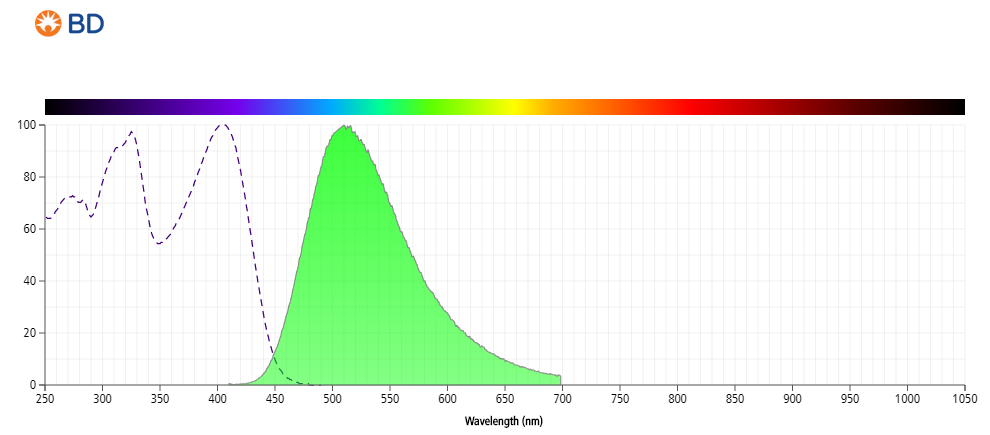
The BD Horizon Brilliant Violet™ 510 (BV510) Dye is part of the BD Horizon Brilliant Violet™ family of dyes. This polymer-technology based dye has an excitation maximum (Ex-Max) at 327 nm/405 nm and an emission maximum (Em-Max) at 512 nm. BV510, driven by BD innovation, is designed to be excited by the violet laser (405 nm) and detected using an optical filter centered near 510 nm (e.g., 525/50 bandpass filter). The dye can be excited by the UV (355 nm) laser resulting in cross-laser excitation and spillover.
-
BD Horizon Brilliant Violet™ 605 (BV605) (Ex-Max 407 nm/Em-Max 605 nm)
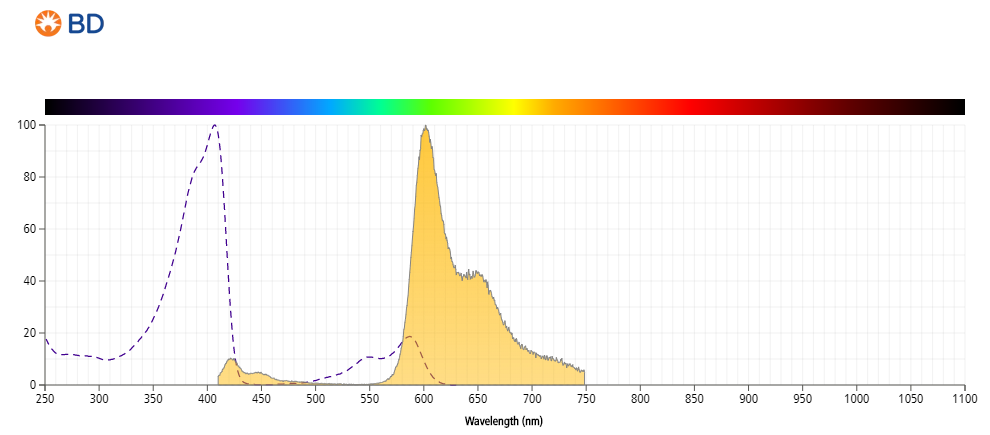
The BD Horizon Brilliant Violet™ 605 (BV605) Dye is part of the BD Horizon Brilliant Violet™ family of dyes. This tandem fluorochrome is comprised of a BV421 donor with an excitation maximum (Ex-Max) of 407 nm and an acceptor dye with an emission maximum (Em-Max) at 605 nm. BV605, driven by BD innovation, is designed to be excited by the violet laser (405 nm) and detected using an optical filter centered near 610 nm (e.g., 610/20-nm bandpass filter). The acceptor dye can be excited by the yellow-green (561 nm) laser resulting in cross-laser excitation and fluorescence spillover.
-
BD Horizon Brilliant Violet™ 650 (BV650) (Ex-Max 406 nm/Em-Max 649 nm)
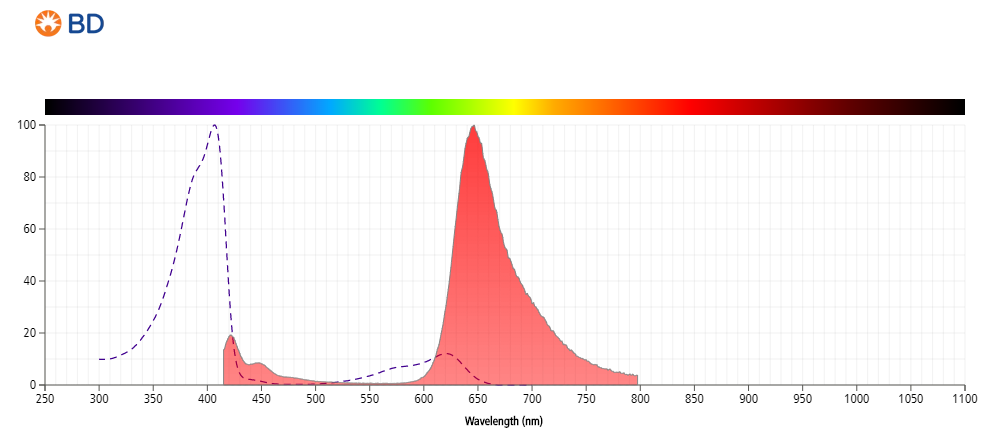
The BD Horizon Brilliant Violet™ 650 (BV650) Dye is part of the BD Horizon Brilliant Violet™ family of dyes. This tandem fluorochrome is comprised of a BV421 donor with an excitation maximum (Ex-Max) of 406 nm and an acceptor dye with an emission maximum (Em-Max) at 649 nm. BV650, driven by BD innovation, is designed to be excited by the violet laser (405 nm) and detected using an optical filter centered near 650 nm (e.g., 660/20-nm bandpass filter). The acceptor dye can be excited by the red (628–640 nm) laser resulting in cross-laser excitation and fluorescence spillover.
-
BD Horizon Brilliant Violet™ 711 (BV711) (Ex-Max 407 nm/Em-Max 711 nm)

The BD Horizon Brilliant Violet™ 711 (BV711) Dye is part of the BD Horizon Brilliant Violet™ family of dyes. This tandem fluorochrome is comprised of a BV421 donor with an excitation maximum (Ex-Max) of 407 nm and an acceptor dye with an emission maximum (Em-Max) at 713 nm. BV711, driven by BD innovation, is designed to be excited by the violet laser (405 nm) and detected using an optical filter centered near 710 nm (e.g., 712/20-nm bandpass filter). The acceptor dye can be excited by the red (628–640 nm) laser resulting in cross-laser excitation and fluorescence spillover.
-
BD Horizon Brilliant Violet™ 750 (BV750) (Ex-Max 409 nm/Em-Max 754 nm)
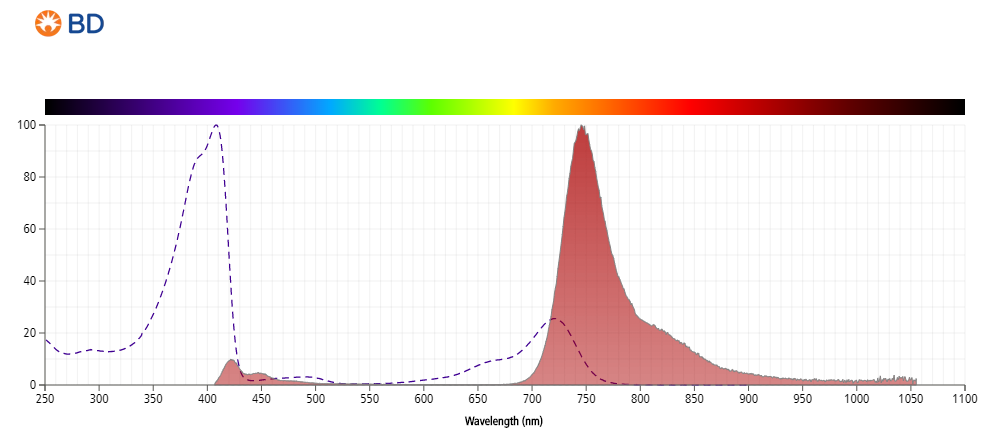
The BD Horizon Brilliant Violet™ 750 (BV750) Dye is part of the BD Horizon Brilliant Violet™ family of dyes. This tandem fluorochrome is comprised of a BV421 donor with an excitation maximum (Ex-Max) of 409 nm and an acceptor dye with an emission maximum (Em-Max) at 754 nm. BV750, driven by BD innovation, is designed to be excited by the violet laser (405 nm) and detected using an optical filter centered near 750 nm (e.g., 750/30 nm bandpass filter).
-
BD Horizon Brilliant Violet™ 786 (BV786) (Ex-Max 407 nm/Em-Max 786 nm)
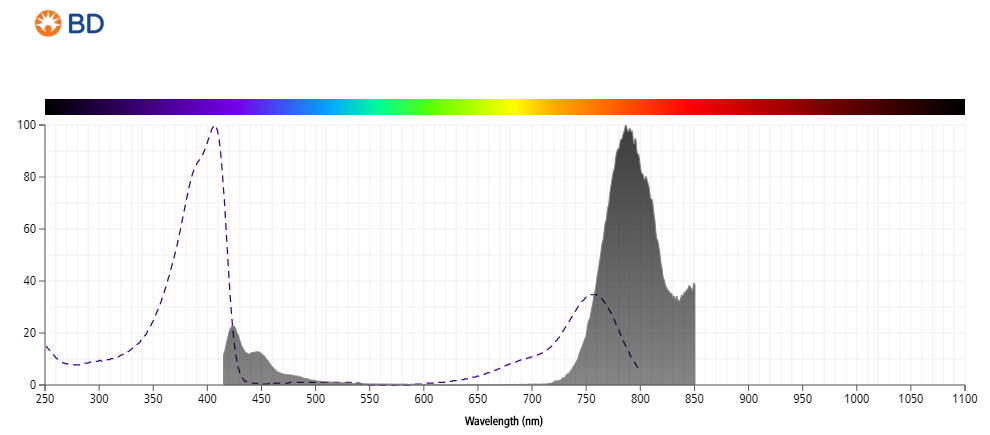
The BD Horizon Brilliant Violet™ 786 (BV786) Dye is part of the BD Horizon Brilliant Violet™ family of dyes. This tandem fluorochrome is comprised of a BV421 donor with an Ex-Max of 407 nm and an acceptor dye with an Em-Max at 786 nm. BV711, driven by BD innovation, is designed to be excited by the violet laser and detected using a filter, centered near 785 nm (e.g., 780/60-nm bandpass filter). Please ensure that your instrument’s configurations (lasers and filters) are appropriate for this dye.
-
FITC (Ex-Max 494 nm/Em-Max 518 nm)
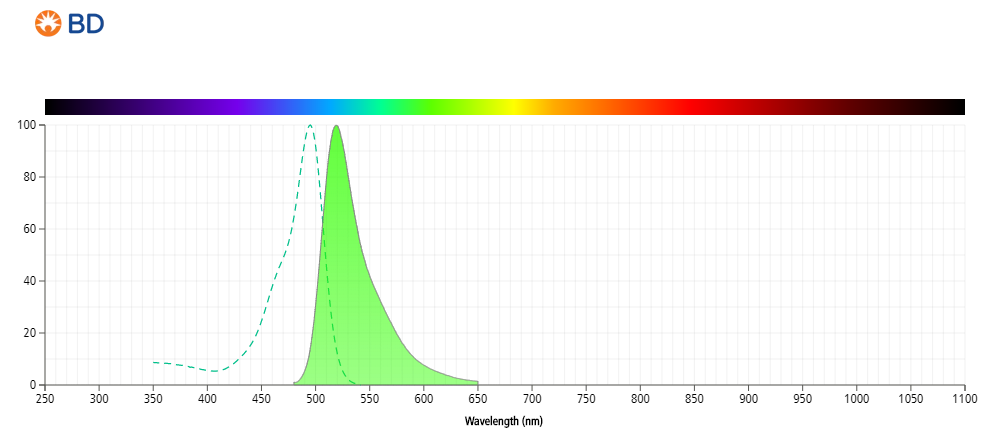
Fluorescein (FITC) is part of the BD blue family of dyes. This is a small organic fluorochrome with an excitation maximum (Ex-Max) at 494 nm and an emission maximum (Em-Max) at 518 nm. FITC is designed to be excited by the blue laser (488 nm) and detected using an optical filter centered near 520 nm (e.g., 530/30-nm bandpass filter).
-
Alexa Fluor™ 488 (Ex-Max 494 nm/Em-Max 517 nm)
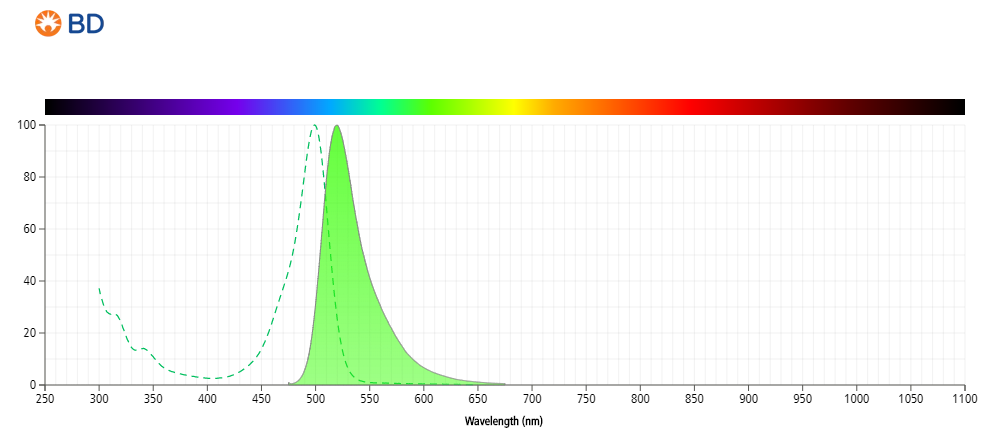
Alexa Fluor™ 488 Dye is part of the BD blue family of dyes. This is a small organic fluorochrome with an excitation maximum (Ex-Max) at 494-nm and an emission maximum (Em-Max) at 517 nm. Alexa Fluor™ 488 is designed to be excited by the blue laser (488 nm) and detected using an optical filter centered near 520 nm (e.g., 530/30-nm bandpass filter).
-
BD Horizon Brilliant™ Blue 515 (BB515) (Ex-Max 490 nm/Em-Max 515 nm)

The BD Horizon Brilliant™ Blue 515 (BB515) Dye is part of the BD Horizon Brilliant™ Blue family of dyes. This dye is a polymer fluorochrome with an excitation maximum (Ex-Max) at 490 nm and an emission maximum (Em-Max) of 515 nm. Driven by BD innovation, BB515 is designed to be excited by the blue laser (488 nm) and detected using an optical filter centered near 520 nm (e.g., 530/30-nm bandpass filter). BB515 reagents are significantly brighter than equivalent FITC or Alexa Fluor™ 488 reagents with less spillover into the PE detector.
-
BD Horizon Brilliant™ Blue 700 (BB700) (Ex-Max 476 nm/Em-Max 695 nm)
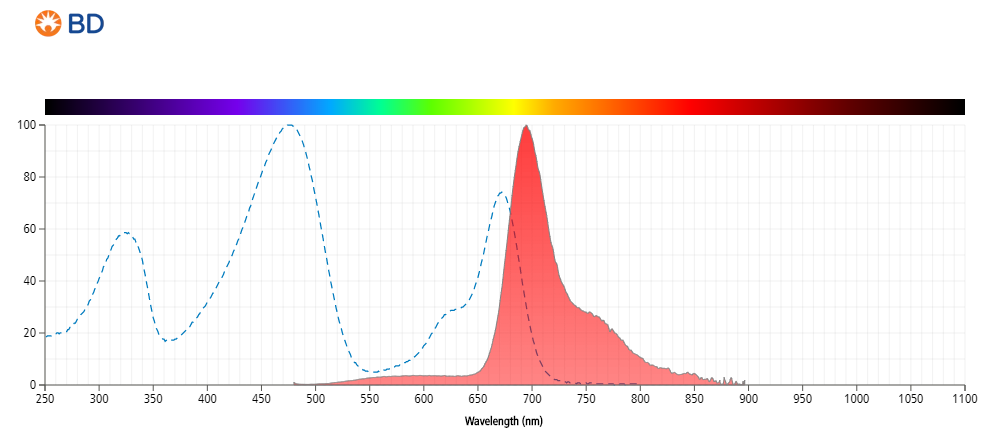
The BD Horizon Brilliant™ Blue 700 (BB700) Dye is part of the BD Horizon Brilliant™ Blue family of dyes. This tandem fluorochrome is comprised of a polymer-technology dye donor with an excitation maximum (Ex-Max) of 476 nm and an acceptor dye with an emission maximum (Em-Max) at 695 nm. Driven by BD innovation, BB700 is designed to be excited by the blue laser (488 nm) and detected using an optical filter centered near 695 nm (e.g., 695/20-nm bandpass filter). The donor dye can be excited by the violet (405 nm) laser and the acceptor dye can be excited by the red (627–640 nm) laser resulting in cross-laser excitation and fluorescence spillover. BB700 reagents are significantly brighter than equivalent PerCP or PerCP-Cy5.5 reagents and are less sensitive to photobleaching. In addition, BB700 shows much less excitation by the violet (407 nm) laser resulting in less spillover. BB700 has minimal yellow-green (562 nm) excitation and is ideal for instruments with both blue (488 nm) and yellow-green (562 nm) lasers.
-
PerCP (Ex-Max 481 nm/Em-Max 675 nm)
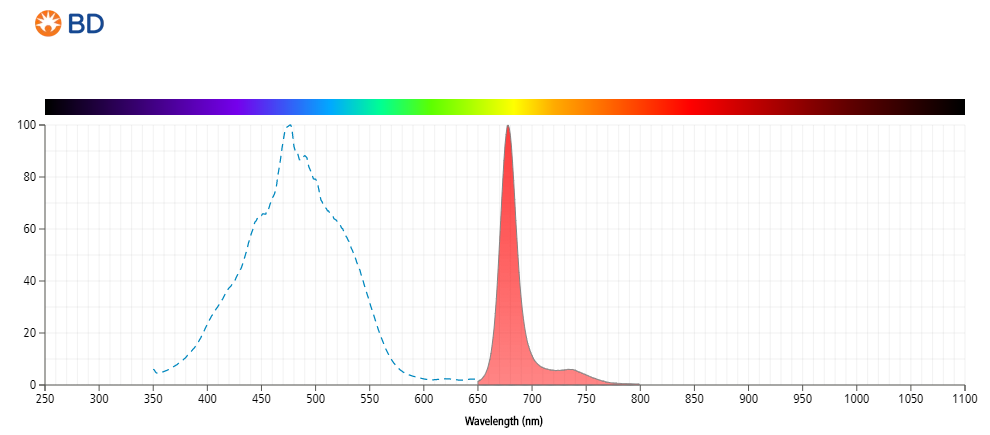
PerCP dye is part of the BD blue family of dyes. This dye is a fluorescent protein complex with an excitation maximum (Ex-Max) of 481 nm and an emission maximum (Em-Max) at 675 nm. PerCP is designed to be excited by the blue laser (488 nm) and detected using an optical filter centered near 680 nm (e.g., 695/40 nm bandpass filter). The donor dye can be partially excited by the violet (405 nm) laser resulting in cross-laser excitation and fluorescence spillover.
-
PerCP-Cy5.5 (Ex-Max 482 nm/Em-Max 676 nm)

PerCP-Cy5.5 dye is part of the BD blue family of dyes. This tandem fluorochrome is comprised of a fluorescent protein complex (PerCP) with an excitation maximum (Ex-Max) of 482 nm and an acceptor dye with an emission maximum (Em-Max) at 676 nm. PerCP-Cy5.5 is designed to be excited by the blue laser (488 nm) and detected using an optical filter centered near 680 nm (e.g., 695/40-nm bandpass filter). The donor dye can be partially excited by the violet (405 nm) laser resulting in cross-laser excitation and fluorescence spillover.
-
PE (Ex-Max 496 nm and 566 nm/Em-Max 576 nm)

R-phycoerythrin (PE) is part of the BD family of phycobiliprotein dyes. This fluorochrome is a multimeric fluorescent phycobiliprotein with excitation maximum (Ex-Max) of 496 nm and 566 nm and an emission maximum (Em-Max) at 576 nm. PE is designed to be excited by the blue (488 nm), green (532 nm) and yellow-green (561 nm) lasers and detected using an optical filter centered near 575 nm (e.g., 575/26-nm bandpass filter). As PE is excited by multiple lasers, this can result in cross-laser excitation and fluorescence spillover on instruments with various combinations of blue, green and yellow-green lasers.
-
BD Horizon™ PE-CF594 (Ex-Max 496 nm and 566 nm /Em-Max 615 nm)
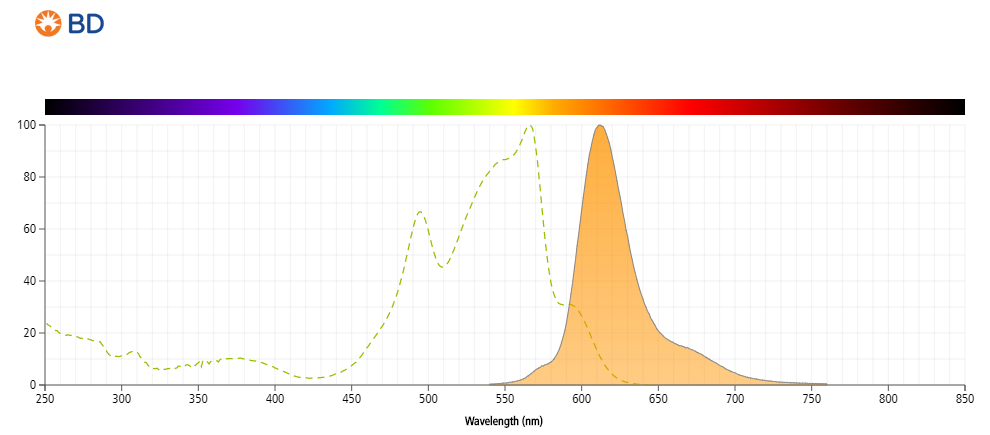
BD Horizon™ PE-CF594 Dye is a part of the BD PE family of dyes. This tandem fluorochrome is comprised of a R-phycoerythrin (PE) donor that has excitation maxima (Ex-Max) of 496 nm and 566 nm and an acceptor dye with an emission maximum (Em-Max) at 615 nm. PE-CF594, driven by BD innovation, is designed to be excited by the blue (488 nm), green (532 nm) and yellow-green (561 nm) lasers and detected using an optical filter centered near 615 nm (e.g., 610/20-nm bandpass filter). The donor dye can be excited by the blue (488 nm), green (532 nm) and yellow-green (561 nm) lasers and the acceptor dye can be excited by the green (532 nm) laser resulting in cross-laser excitation and fluorescence spillover.
-
PE-Cy5 (Ex-Max 496 nm and 566 nm /Em-Max 670 nm)
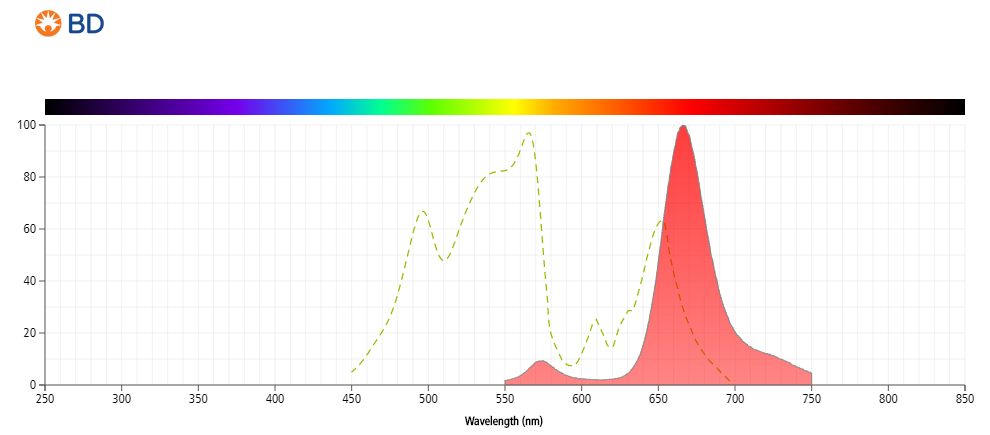
PE-Cy5 dye is a part of the BD PE family of dyes. This tandem fluorochrome is comprised of a R-phycoerythrin (PE) donor that has excitation maxima (Ex-Max) of 496 nm and 566 nm and an acceptor dye, Cy5, with an emission maximum (Em-Max) at 670 nm. PE is designed to be excited by the blue (488 nm), green (532 nm) and yellow-green (561 nm) lasers and detected using an optical filter centered near 670 nm (e.g., 670/20-nm bandpass filter). The donor dye can be excited by the blue (488 nm), green (532 nm) and yellow-green (561 nm) lasers and the acceptor dye can be excited by the red (627–640 nm) laser resulting in cross-laser excitation and fluorescence spillover.
-
PE-Cy7 (Ex-Max 496 nm and 566 nm /Em-Max 781 nm)

PE-Cy7 dye is a part of the BD PE family of dyes. This tandem fluorochrome is comprised of a R-phycoerythrin (PE) donor that has excitation maxima (Ex-Max) of 496 nm and 566 nm and an acceptor dye, Cy7, with an emission maximum (Em-Max) at 781 nm. PE can be excited by the blue (488 nm), green (532 nm) and yellow-green (561 nm) lasers and detected using an optical filter centered near 781 nm (e.g., 760/60-nm bandpass filter). The donor dye can be excited by the blue (488 nm), green (532 nm) and yellow-green (561 nm) lasers and the acceptor dye can be excited by the red (627–640 nm) laser resulting in cross-laser excitation and fluorescence spillover.

-
Alexa Fluor™ 647 (Ex-Max 653 nm/Em-Max 669 nm)
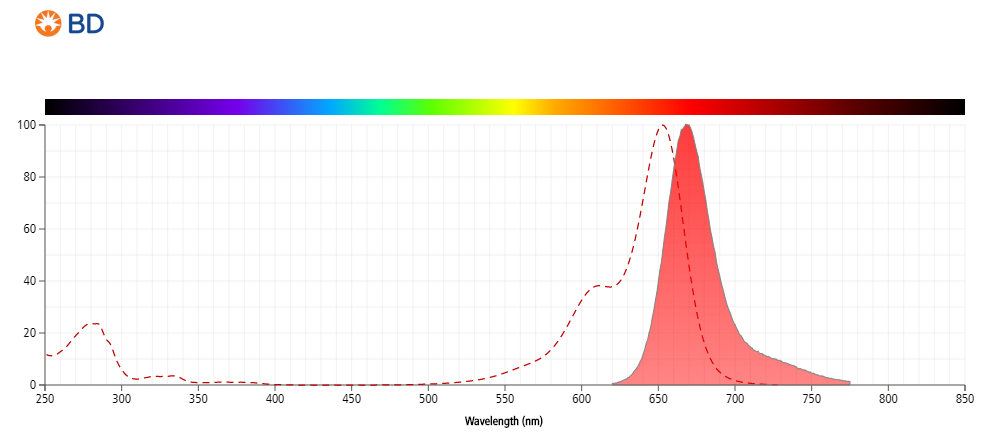
Alexa Fluor™ 647 Dye is part of the BD red family of dyes. This is a small organic fluorochrome with an excitation maximum (Ex-Max) at 653 nm and an emission maximum (Em-Max) at 669 nm. Alexa Fluor™ 647 is designed to be excited by the red (627–640 nm) laser and detected using an optical filter centered near 520 nm (e.g., 660/20 nm bandpass filter).
-
APC (Ex-Max 651 nm/Em-Max 660 nm)
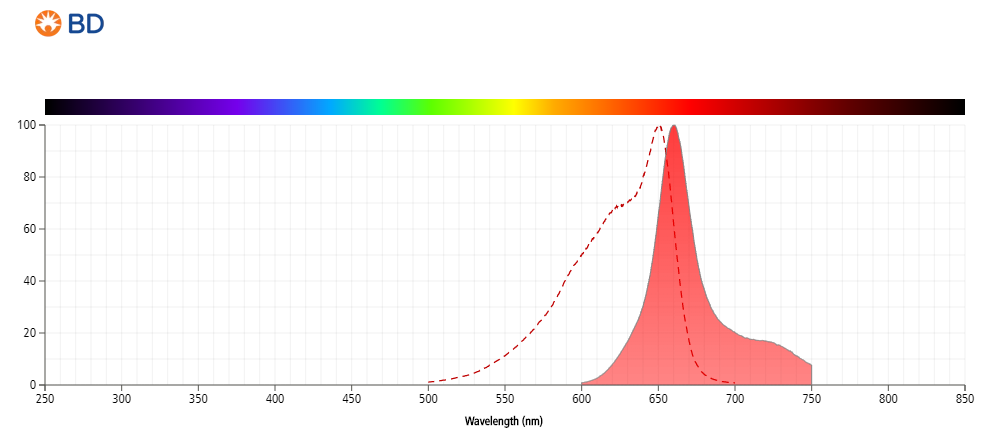
Allophycocyanin (APC) is part of the BD family of phycobiliprotein dyes. This fluorochrome is a multimeric fluorescent phycobiliprotein with excitation maximum (Ex-Max) of 651 nm and an emission maximum (Em-Max) at 660 nm. APC is designed to be excited by the red (627–640 nm) laser and detected using an optical filter centered near 660 nm (e.g., 660/20 nm bandpass filter).
-
Alexa Fluor™ 700 (Ex-Max 694 nm/Em-Max 719 nm)
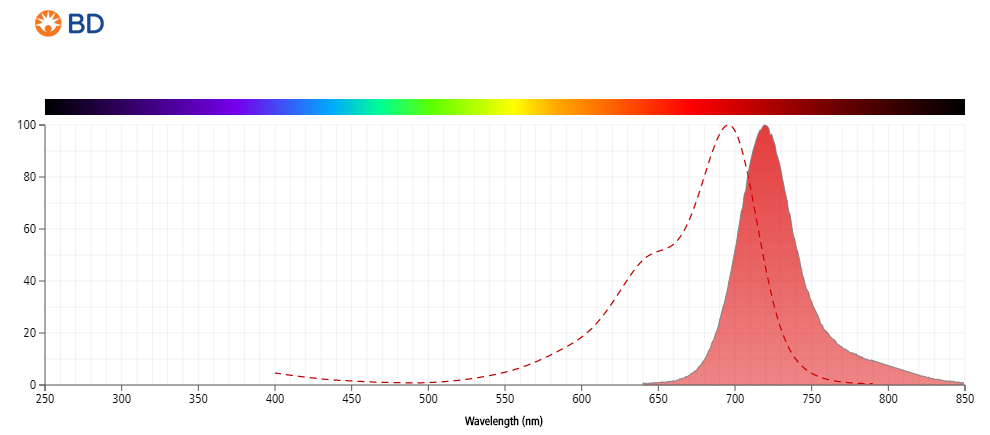
Alexa Fluor™ 700 Dye is part of the BD red family of dyes. This is a small organic fluorochrome with an excitation maximum (Ex-Max) at 697 nm and an emission maximum (Em-Max) at 719 nm. Alexa Fluor™ 700 is designed to be excited by the red (627–640 nm) laser and detected using an optical filter centered near 720 nm (e.g., 720/40-nm bandpass filter).
-
BD Horizon™ APC-R700 (Ex-Max 651 nm/Em-Max 706 nm)
 The BD Horizon™ APC-R700 Dye is a part of the BD APC red family of dyes. This tandem fluorochrome is comprised of an allophycocyanin (APC) dye donor that has excitation maximum (Ex-Max) of 651 nm and an acceptor dye, R700, with an emission maximum (Em-Max) at 706 nm. APC-R700, driven by BD innovation, is designed to be excited by the red (627–640 nm) laser and detected using an optical filter centered near 710 nm (e.g., 720/40-nm bandpass filter). APC-R700 is a brighter alternative to Alexa Fluor™ 700.
The BD Horizon™ APC-R700 Dye is a part of the BD APC red family of dyes. This tandem fluorochrome is comprised of an allophycocyanin (APC) dye donor that has excitation maximum (Ex-Max) of 651 nm and an acceptor dye, R700, with an emission maximum (Em-Max) at 706 nm. APC-R700, driven by BD innovation, is designed to be excited by the red (627–640 nm) laser and detected using an optical filter centered near 710 nm (e.g., 720/40-nm bandpass filter). APC-R700 is a brighter alternative to Alexa Fluor™ 700. -
BD Horizon™ Red 718 (Ex-Max 695 nm/Em-Max 718 nm)
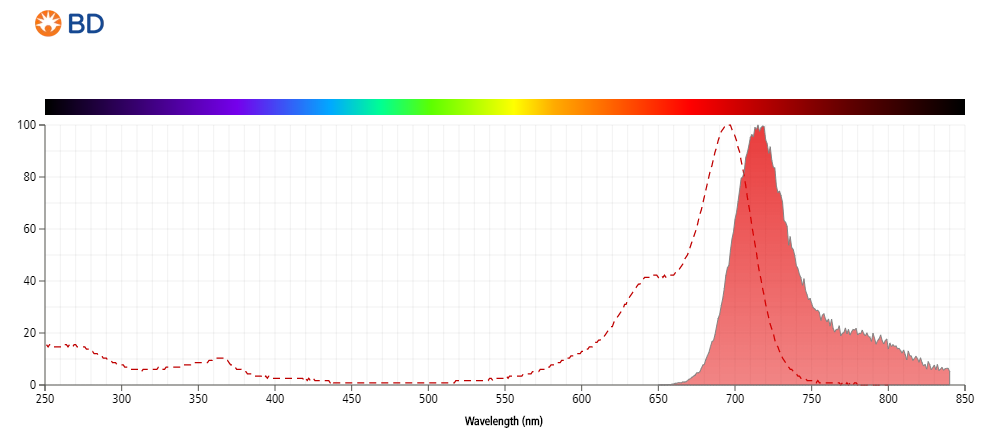 The BD Horizon™ Red 718 (R718) Dye is part of the BD red family of dyes. It is a small organic fluorochrome with an excitation maximum (Ex-Max) at 695 nm and an emission maximum (Em-Max) at 718 nm. Driven by BD innovation, R718 is designed to be excited by the red laser (627–640 nm) and detected using an optical filter centered near 720 nm (e.g., 720/40-nm bandpass filter). R718 is a brighter alternative to Alexa Fluor™ 700. R718 is also a bright small molecule alternative to APC-R700 with lower spread into the APC detector.
The BD Horizon™ Red 718 (R718) Dye is part of the BD red family of dyes. It is a small organic fluorochrome with an excitation maximum (Ex-Max) at 695 nm and an emission maximum (Em-Max) at 718 nm. Driven by BD innovation, R718 is designed to be excited by the red laser (627–640 nm) and detected using an optical filter centered near 720 nm (e.g., 720/40-nm bandpass filter). R718 is a brighter alternative to Alexa Fluor™ 700. R718 is also a bright small molecule alternative to APC-R700 with lower spread into the APC detector. -
APC-Cy7 (Ex-Max 651 nm/Em-Max 779 nm)

APC-Cy7 dye is a part of the BD APC red family of dyes. This tandem fluorochrome is comprised of a allophycocyanin (APC) donor that has excitation maxima (Ex-Max) of 651 nm and an acceptor dye, Cy7, with an emission maximum (Em-Max) at 779 nm. APC-Cy7 can be excited by the red (627–640 nm) laser and detected using an optical filter centered near 780 nm (e.g., 760/60-nm bandpass filter).
-
APC-H7 (Ex-Max 659 nm/Em-Max 782 nm)
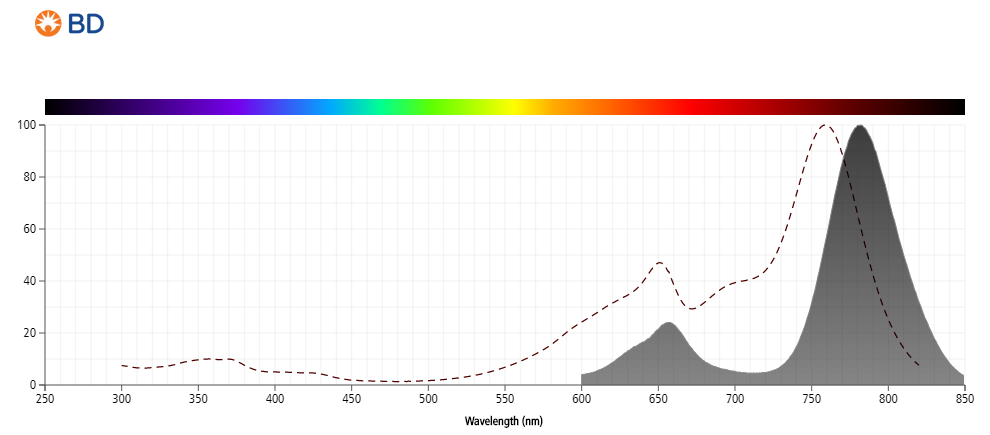
The BD Horizon™ APC-H7 Dye is a part of the BD APC red family of dyes. This tandem fluorochrome is comprised of a allophycocyanin (APC) donor that has excitation maxima (Ex-Max) of 659 nm and an acceptor dye, H7, with an emission maximum (Em-Max) at 782 nm. APC-H7, driven by BD innovation, is designed to be excited by the red (627–640 nm) laser and detected using an optical filter centered near 780 nm (e.g., 760/60-nm bandpass filter).
For Research Use Only. Not for use in diagnostic or therapeutic procedures.
Alexa Fluor and Pacific Blue are trademarks of Life Technologies Corporation. CF is trademark of Biotium, Inc. Cy is a trademark of Global Life Sciences Solutions Germany GmbH or an affiliate doing business as Cytiva.
23-23334-00
Report a Site Issue
This form is intended to help us improve our website experience. For other support, please visit our Contact Us page.